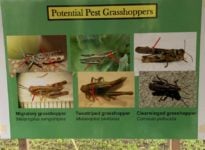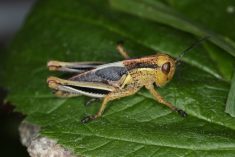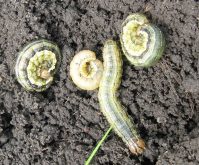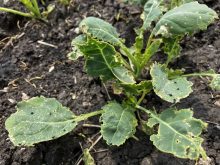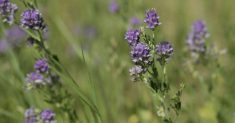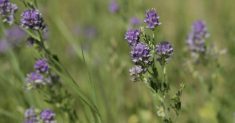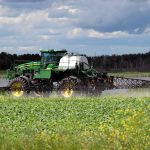Manitoba’s weather has been good for grasshoppers in the last three years, and now some fields are paying the price.
“Right now, there’s pockets in the province that do have some very high levels of grasshoppers,” provincial entomologist John Gavloski said. “There’s quite a bit of edge spraying going on where people are trying to control the populations around their field edges. There is some whole field spraying going on as well, but most of it is, right now, edge spraying.”
Why it matters: Grasshopper populations have been climbing in the last three years, but not all grasshoppers are equal and even different pest species may be a threat to different crops.
Read Also

CUSMA access key among other trade noise: Seeds Canada panel
Seeds Canada conference panelists say Canada needs to stay focused and wait as U.S. trade and tariff chaos develops, and a Canada-U.S.-Mexico Agreement review looms
That may change as insects mature and become capable of flight and therefore more mobile, he added. The two-striped grasshopper will be anywhere between the third and fifth instar as of early July, Gavloski said, although another pest species, migratory grasshopper, seems to be further ahead.
Some non-pest species mature more quickly than the two-striped grasshopper, and should not be confused.
Farmers have had to spray in grasshopper “hot spots,” the province’s insect and disease report said July 11.
The pests have taken a chunk out of the already stressed hay crops in the northwest and Interlake. The July 9 provincial crop report noted both grasshopper and alfalfa weevil damage across both regions.
In early July, producers in the northern Interlake expressed concern that grasshopper damage would chip away at what little first cut they expected.
“All you’re left with is a stem,” producer Arden Weigelt of Moosehorn said in late June.
The region was beset by poor growing conditions and little rainfall in the first part of the season and many pastures were “just hanging on,” the province reported July 9.
The eastern part of central Manitoba has also taken a hit. Some fields had seen economic thresholds and were being sprayed, the province said, while forage stands got a double hit of grasshopper and alfalfa weevil, much like regions farther north.
Haying in the east forced grasshoppers into neighbouring annual crops, the report went on. Grasshoppers were noted in cereal crops in the region.
The two-striped grasshopper has caused the most problems this year.
Gavloski counts three pest grasshopper species out of over 80 kinds of grasshopper and katydid present in the province. Both two-striped and migratory grasshopper are threats to crop, he said, along with the clear-winged grasshopper.
“It’s really not a great name because the wing that you see when they’re sitting with the wings folded is the forewing, which actually has some big black dots on it,” he said. “The clear wing is actually the hind wing, which gets covered by the forewing when they’re seated.”
Clear-winged grasshoppers tend to target grass and cereals, while migratory and two- striped grasshopper have a more varied diet, he said. Two-striped grasshopper prefers broadleaf crops, Gavloski added, although it will feed on grasses and cereals as well.
Name that hopper
Only three grasshopper species are a true threat to crops and even those different species may be more of a threat to some crops than others, according to the province. Here’s what to watch out for:
Migratory grasshopper
- Black mask-like markings behind the head on both juvenile and adult;
“V” markings on leg; - Rectangular markings on wing when seated.
Two-striped grasshopper
- Light stripes from head to wing in adults;
- Dark stripes on thorax in juveniles;
- Slightly larger than migratory grasshopper;
- Dark leg band in both juvenile and adult.
Clear-winged grasshopper
- Dark dots on wing when seated;
- Clear hind wing.
